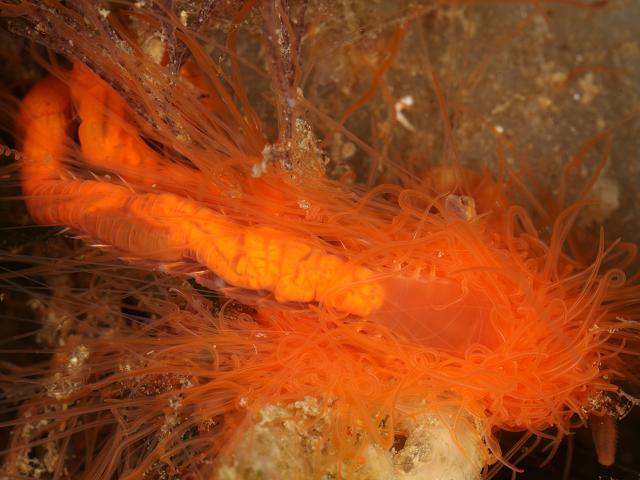
APHOTOMARINE
An educational resource dedicated mainly to the photography
and diversity of marine life that can be found in coastal waters
and intertidal areas of Great Britain and Ireland by David Fenwick.

Polycirrus caliendrum Claparède, 1869? - A terebellid worm (Marine worm images)
Scroll down and rollover titles to change screen image or click on title to view image.
Terebellid worm
Polycirrus caliendrum
- on marina pontoon 1
Polycirrus caliendrum
- on marina pontoon 1
Terebellid worm
Polycirrus caliendrum
- on marina pontoon 2
Terebellid worm
Polycirrus caliendrum
- collected from a marina 1
Terebellid worm
Polycirrus caliendrum
- ventral view anterior 1
Terebellid worm
Polycirrus caliendrum
- dorsal view anterior 1
Terebellid worm
Polycirrus caliendrum
- ventral anterior close-up 1
Terebellid worm
Polycirrus caliendrum
- ventral anterior close-up 2
Terebellid worm
Polycirrus caliendrum
- ventral anterior close-up 3
Terebellid worm
Polycirrus caliendrum
- ventral anterior close-up 4
Terebellid worm
Polycirrus caliendrum
- anterior close-up 1
Terebellid worm
Polycirrus caliendrum
- chaetae 1
Terebellid worm
Polycirrus caliendrum
- chaetae 2
Terebellid worm
Polycirrus caliendrum
- anterior uncini 1
Terebellid worm
Polycirrus caliendrum
- anterior uncini 2
Terebellid worm
Polycirrus caliendrum
- anterior uncini 3
The species is commonly found living among tunicates, sea squirts, on marina pontoons. Specimens above collected from Newlyn Marina, Newlyn, Cornwall. 29.06.16, 04.07.17 and 06.07.17.
Terebellid worm
Polycirrus caliendrum
- under rock 1
Terebellid worm
Polycirrus caliendrum
- under rock 2
Terebellid worm
Polycirrus caliendrum
- under rock 3
Terebellid worm
Polycirrus caliendrum
- under rock 4
Terebellid worm
Polycirrus caliendrum
- under rock 5
Terebellid worm
Polycirrus caliendrum
- under rock 6
Specimens above found on various dates, under stones on the lowershore around Penzance, Cornwall.
Whilst being very common at marinas this species also occurs under stones on rocky shores in Penzance and wider Mounts Bay. The issue with the identity of this worm isn't as much with its features, its morphology, but with how it was originally described, as there are numerous nomenclature problems with Polycirrus. The sequencing of polychaetes has also found many cryptic species, so it is difficult to be sure at times what one is dealing with.
Polycirrus species are generally attacked by an endoparasitic copepod of the genus Entobius.

The main objective of this website is in furthering environmental awareness and education through the medium of photography. To increase awareness and access to the wildlife of the region and help
people find and identify it. Sometimes the difference between species is obvious but many species can only be determined by observing microscopic characteristics that are specific to any one species.